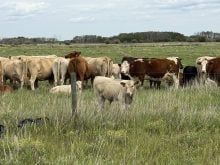This cattle market information is selected from the weekly report from Canfax, a division of the Canadian Cattlemen’s Association. More market information, analysis and statistics are available by becoming a Canfax subscriber by calling 403-275-5110 or at www.canfax.ca.
Fed prices steady
Alberta direct cattle sales saw moderate volume cash trade last week, and prices were steady with the previous week. Most sales were reported dressed from $264-$265 per hundredweight delivered.
Read Also

Malting barley exporters target Mexican market
Canada’s barley sector is setting its sights on the Mexican market to help mop up some of the lost demand from China
Packer inventories have swelled out to the third week of November. Total Canadian fed slaughter for the week ending Oct. 9 was four percent larger than the previous week at 57,993 head and nine percent larger than the five-year historic average. Year to date, Canadian fed slaughter was 10 percent larger than a year ago, totalling 2,172,815 head.
Canadian steer carcass weights surged 12 pounds larger than the previous week to 948 lb., the third largest so far this year, and Alberta steer weights set a new annual high at 953 lb.
Canadian fed cattle and cow exports to the United States for the week ending Oct. 2 were down two percent from the previous week to 10,458 head but were 24 percent larger than the same week last year. Year to date, exports were down 12 percent totalling 320,495 head.
Ontario saw active trade last week with the bulk of reported sales at $270 per cwt. delivered. Eastern packers appear to have ample kill inventory for October and are pushing deliveries into November.
The North American fed market remains range bound with ample market-ready packer inventory to work through in most feeding areas. Carcass weights are expected to trend larger through this month.
In the U.S., northern live trade was reported in a full US$122-$125 per cwt. trade range and closed last week $1 per cwt. higher at a $124 per cwt. weekly average. Northern dressed trade was around 50 cents per cwt. higher than the previous week’s Nebraska rail average, with most at $196 per cwt. delivered.
Cow prices take a dive
Compared to the second half of September, non-fed volumes have increased with many auction facilities reporting 200 to 300 cows at weekly sales. The non-fed market has hit a rough patch and prices have been disappointing relative to the fed cattle market.
Averaging slightly more than $75 per cwt., prices have dropped by $5 per cwt. over the previous two weeks, the lowest point since February. For the first half of October, this is the lowest D2 cow prices have been since 2012. D2s averaged $75.80 last week, and D3s averaged $66.07 per cwt.
Canadian butcher bull exports to the U.S. have averaged 939 head per week in recent weeks, compared to 1,068 head per week in the same five-week period last year.
Ontario cow prices declined $6 per cwt. last week. Eastern Canadian cow slaughter has been more than 2,800 head per week over the past two weeks, the largest weekly slaughter since December 2018.
Steers hit new low
Alberta, Saskatchewan and Manitoba 500-600 lb. steer calves all averaged $215 per cwt. It is a new annual low for Alberta, while Saskatchewan and Manitoba prices are within $1 per cwt. of their lows set in January. October has the highest probability of seeing fourth quarter price lows for 550 lb. steer calves. This has occurred in eight of the past 14 years.
The tough spot on the market continues to be lighter weight heifer calves. Over the past two weeks there have been few price differences between 550, 650 and 750 lb. heifers. Last week the price difference between a 550 lb. and a 750 lb. heifer was $3.25 per cwt., the narrowest since September 2016. Over the past five years, the average price spread between a 550 and 750 lb. heifer for October is $8 per cwt.
Yearling prices remain strong as prices for feeders heavier than 800 lb. trade within $2-$4 per cwt. of their highs posted four to five weeks ago. However, basis levels weakened in the past two weeks, ranging from -$4.60 to -$8.73 per cwt. It is the weakest basis for October since 2014.
For the week ending Oct. 2, Canadian feeder exports totalled 4,871 head. Feeder cattle imports from the U.S. for August totalled slightly more than 27,000 head. From January to August, imports of U.S. feeders are up 133,000 head compared to last year.
Cutout lower
In U.S. beef trade, cut-out values saw moderate declines. Choice averaged US$280.32 and Select averaged $260.68 per cwt.














